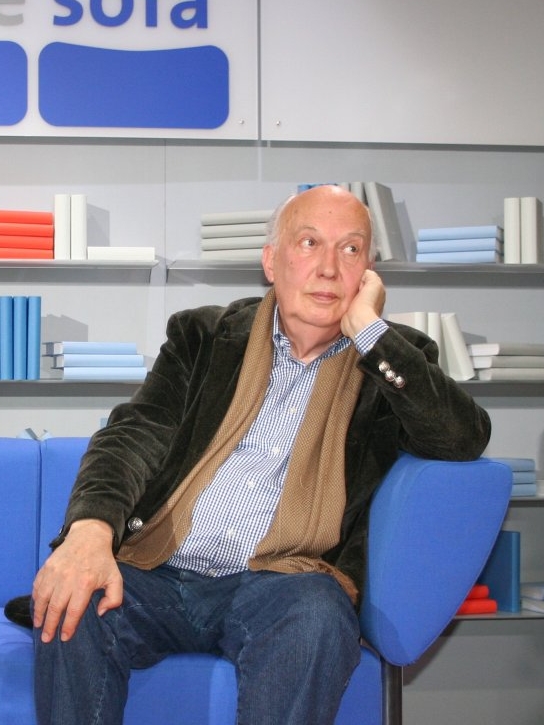It is with deep sadness that we have to announce the loss of our friend and most helpful member of our Association, Professor Werner Hofmann, whose death occurred suddenly in Hamburg on 13 March 2013.
This great art historian was one of the last very distinguished representatives of the famous “Vienna School” of art history that proudly embraced thinkers of such originality and brilliance as Max Dvorak, Aloïs Riegl, Julius von Schlosser and, later, Ernst Gombrich, with whom Werner Hofmann had very close ties.
From 1962 to 1969 Werner Hofmann was a founding Director of the Vienna Museum of Art, later moving to the Kunsthalle in Hamburg, of which he was Director from 1969 to 1990. Here, he achieved the remarkable exhibition cycle “Art around 1800” (Goya, Runge, Friedrich, etc.). His interest in this crucial period in the development of European modernity did not prevent Hofmann from being engaged in contemporary art as well – Beys, Hrdlicka, Baselitz and many others (latterly, Richard Deacon, about whom we had a most interesting conversation a year ago).
His numerous books include such innovative texts as “The Earthly Paradise” (Das irdische Paradies, 1960), which provoked a radical renewal of our thinking on 19th-century art. This was followed up very fruitfully in 1973 by Nana : Mythos und Wirklichkeit, which from the starting-point of Manet’s major painting, held in the Kunsthalle collection, traced the whole of the “modern” evolution developed in the artist’s work.
In the wake of his thesis on Daumier, in 1956 Hofmann published Die Karikatur von Leonardo bis Picasso (“Caricature from Leonardo to Picasso”), a first book dealing with a subject long considered as “marginal”, or else regarded with disdain by art history. With highly original views of drawing, and hence of forms in general, his study of caricature opened up unprecedented perspectives on the whole of late 19th– and early 20th-century modern art.
Within Hofmann’s discourse, the “marginal” provided a conceptual key that led to further upheavals and eventually culminated in his theory of “polyfocality” (a term which, being an expert Francophile, Werner Hofmann introduced as the French “polyfocalité” into the German dictionary of the history of art). This concept of polyfocality was one he continued to develop and enrich throughout his latter years.
With his interest in “extra-academic” subjects, Hofmann was at the source of the recent re-evaluation of Mannerism dealt with in his remarkable exhibition “Zauber der Medusa – Europäische Manierismen” (“Fascination of Medusa : European Mannerism) at the Vienna Künstlerhaus, in 1987. In 2010 the book Phantäsiestucke on what was called “Fantastic Art” – rather inappropriately called so, but for want of more satisfactory inspiration the title “Art fantastique” was somewhat unfortunately selected for the French edition by the publishers Actes Sud) – extrapolated and conceptualised the results of the Vienna exhibition.
In conjunction with his provocative and even somehow anti-nationalist writings on the “nature” of German art (see his “Wie deutsch ist die deutsche Kunst”, 1999), reflections on the subject of “Composition” and other subjects completely outside the poisonous stylistic doxa holding sway over the narrowly descriptive history of art, an overview of Hofmann’s work gives the measure of an original thinker who is to be put on a parallel, if not in balance, with Ernst Gombrich, an art historian who, contrary to Werner Hofmann, came to a halt at the threshold of modern art, which he was never able to go beyond, whereas Hofmann was totally at ease with the subject.
His last work will – hopefully ! – further support this view, as for the last two years Werner Hofmann was writing a book on the vitality of the line. The text, which was ready well before the Christmas of 2012, was set to be published by Beck in Munich this spring.
In 1991 Werner Hofmann was awarded the Sigmund Freud Prize for Scientific Prose (Sigmund Freud Preis für wissenschaftlichen Prosa). His 80-th birthday was marked in 2008 by the prestigious Aby Warburg Prize (Aby Warburger Preis), an award of the greatest distinction for a Germanic art historian.
With his death we lose a great friend and art history is deprived of one of the most original writers of the post-war era.
Andrei Nakov, March 2013

Leave a Reply